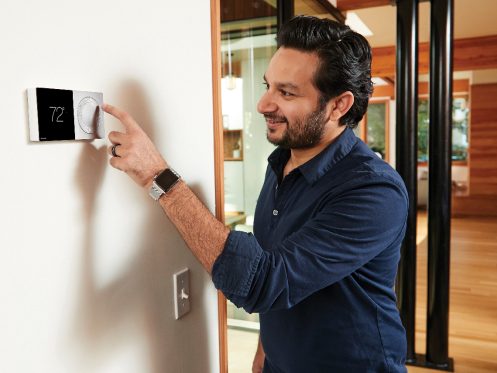The thermostat is essentially the brain of your HVAC system. It signals when the unit should turn on or off and helps maintain your desired indoor temperature by triggering heating or cooling cycles. Some advanced models can even manage humidity levels if your system is integrated with a compatible humidifier or dehumidifier.
To perform these tasks accurately, thermostats are equipped with built-in sensors that analyze the indoor environment to provide a general picture of what’s happening inside your home. If placed in the wrong location, the thermostat can yield misleading readings, compromising energy efficiency and overall system performance.
Here’s a guide on how to improve thermostat placement.
Factors Affecting Thermostat Placement
Thermostat sensors are highly sensitive, and several environmental factors can distort their readings, causing your HVAC system to consume more energy than necessary.
1. Heat Sources
Mounting your thermostat near a window or skylight that receives direct sunlight can expose it to artificially elevated temperatures. Even if the room is comfortably cool, the thermostat may register it as overheating and trigger unnecessary cooling cycles. This results in increased energy use and added wear on HVAC components.
Similarly, installing your thermostat near heat-generating appliances such as ovens, TVs, or computers can have the same effect. These devices emit localized heat that can confuse the thermostat and lead to inaccurate readings.
2. Proximity to Drafts
Drafts from exterior doors or poorly sealed windows carry outdoor temperatures inside. When this air reaches your thermostat, the sensors may record external conditions instead of the actual indoor environment. As a result, your system may overheat or overcool the home based on flawed readings, which leads to higher energy bills and inconsistent comfort.
3. Height and Location Within the Room
Warm air naturally rises while cooler air settles near the floor. If the thermostat is installed too high, it will register warmer temperatures than those felt at the seating or living level. Too low, and it may read cooler than the true ambient conditions.
Both cases cause your HVAC system to work harder than necessary to correct the perceived imbalance, which increases energy usage and can accelerate wear and tear.
4. Hot and Cold Spots
Poor airflow, insulation issues, and blocked vents can all contribute to temperature inconsistencies throughout your home. If the thermostat is located in one of these zones, or on an exterior wall that gains or loses heat easily, it won’t reflect your home’s overall comfort level accurately.
How to Ensure Proper Thermostat Placement
Even if you’re comfortable with DIY, it’s a good idea to consult a licensed HVAC technician when installing or relocating a thermostat. Professionals can assess airflow, home layout, and environmental factors to determine the ideal spot. Still, here are some important guidelines:
Home Layout and Room Usage
Temperature distribution differs across home layouts. Open-concept homes experience more airflow movement, while enclosed rooms trap hot or cold air more easily. A central interior location is best, as it provides a representative sample of the home’s overall climate rather than being influenced by isolated temperature fluctuations.
Proper Height
Install your thermostat at about five feet (52 to 60 inches) above the floor. This height offers a balanced reading of the room’s true conditions, it’s above cooler air near the floor and below the warmer air near the ceiling. It also makes the display accessible for easy manual adjustments.
Away From Home Openings and Drafts
Avoid placing the thermostat near doors, windows, or vents. Draft-prone areas introduce outdoor air that disrupts accurate readings. Similarly, placing the thermostat under return vents or near supply vents can expose it to irregular airflow patterns that don’t represent the room’s overall temperature. Instead, choose a location with steady airflow and minimal exposure to transient conditions.
Contact GVEC Air Conditioning & Heating for More Information
Proper thermostat placement boosts your HVAC system’s energy efficiency, improves comfort, and helps prevent unnecessary repairs or premature system replacement. Our certified technicians can assess your home and identify the ideal thermostat location to ensure optimal system performance.
Call GVEC Air Conditioning & Heating today for professional thermostat installation in Gonzales, Seguin, Schertz, and surrounding areas.



